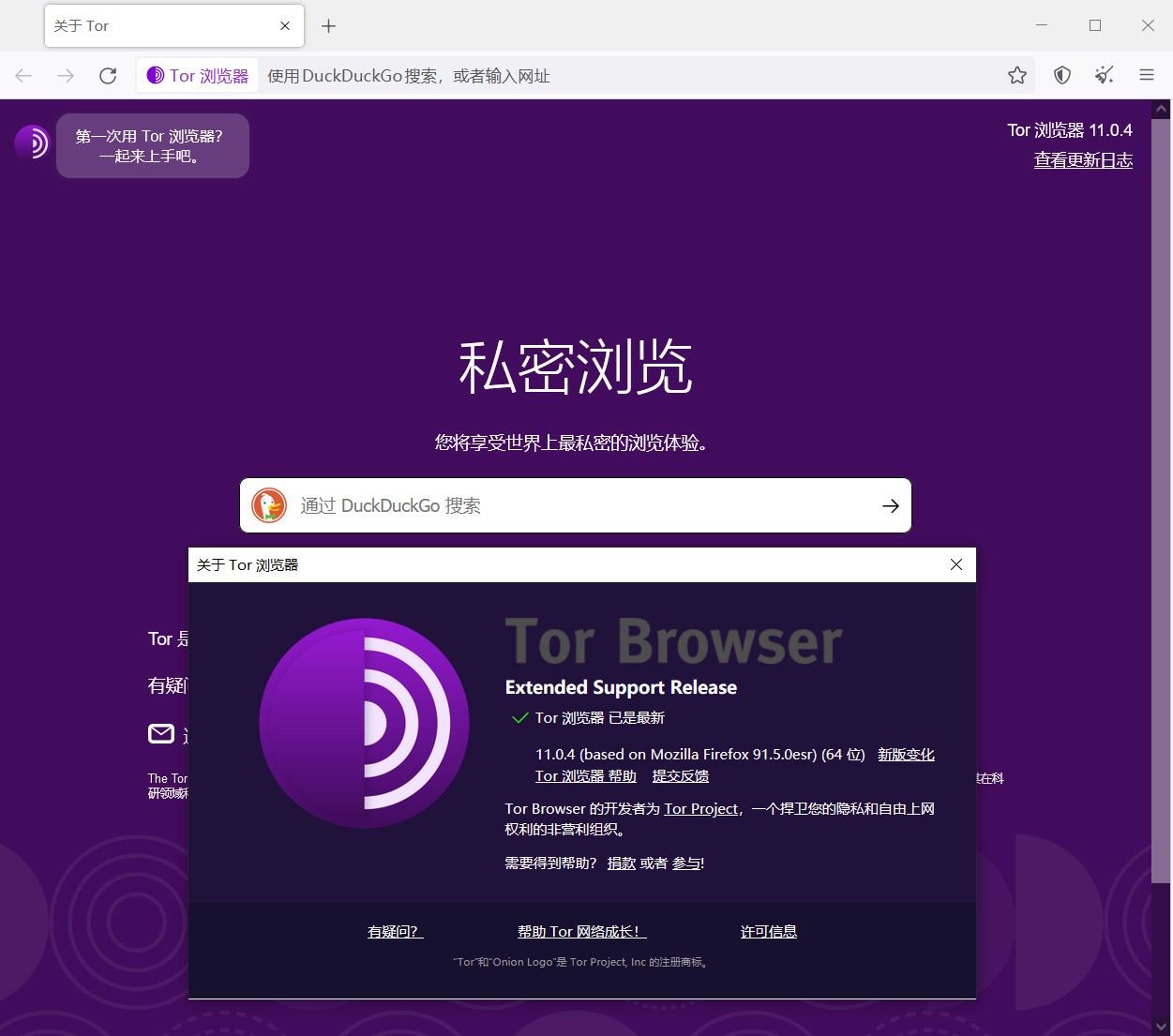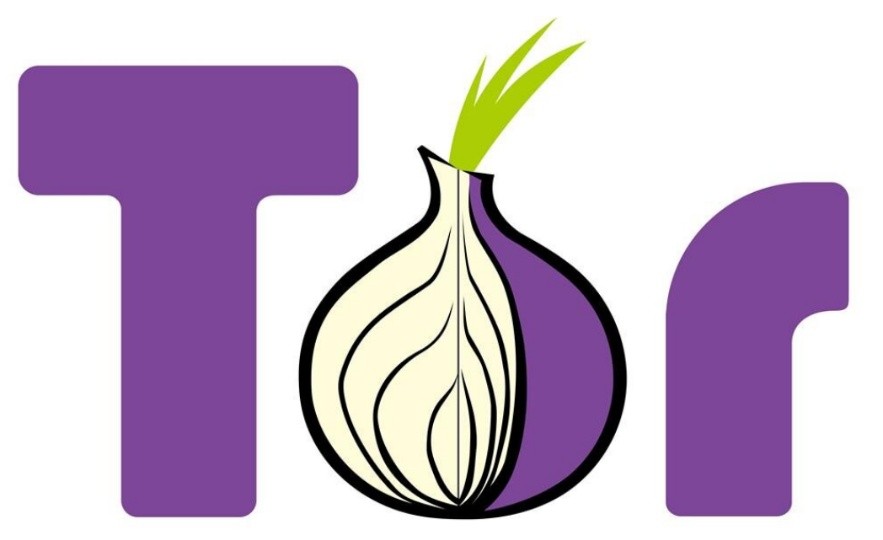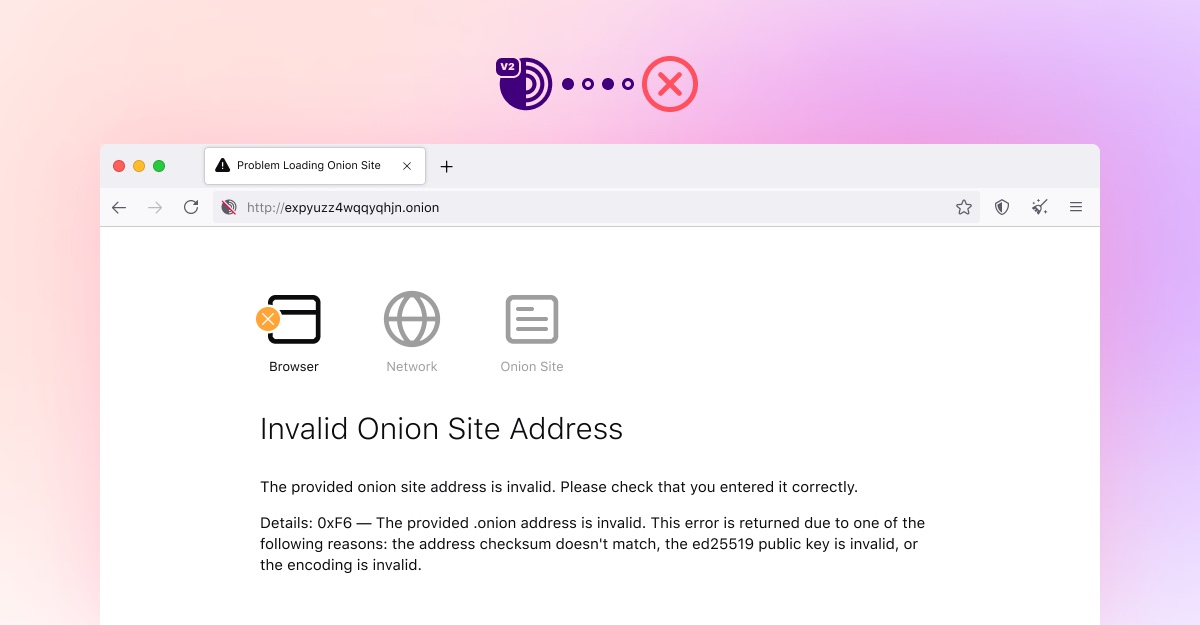(洋葱头浏览器)Tor Browser 11.0.7正式版发布(Win/Mac/Android安卓手机版全平台版本)附官方下载地址
(洋葱头浏览器)Tor Browser 11.0.7正式版在2022年3月8号 发布了(Win/Mac/Linux/Android安卓手机版全平台版本)附官方下载地址 ,此版本主要更新
Tor 浏览器 11.0.7 现在可以从 Tor 浏览器下载页面和我们的分发目录中获得。
此版本包括 Firefox 的重要安全更新:
自11.0.6版本开始超级大更新 包含了全版本的更新
Tor 浏览器 11.0.7 将 Windows、macOS 和 Linux 上的 Firefox 更新至 91.7.0esr。
此次更新并未更新手机版 最新手机版仍然是11.0.6
我们也借此机会更新 Tor 浏览器的其他各种组件:
托尔 0.4.6.10
NoScript 11.3.7
我们还切换到最新的 Go 版本(1.16.14)来构建我们的 Go 相关项目。
自 Tor 浏览器 11.0.7以来的完整更新日志是:
Windows + OS X + Linux 更新 Tor 到 0.4.6.10
将 NoScript 更新到 11.3.7 错误 tor-browser-build#40435:删除默认网桥“deusexmachina” 错误 tor-browser-build#40440:Bump 版本的雪花包含 PT LOG 事件 错误 tor-browser#40684:11.0a10 中的其他 UI 错误 错误 tor-browser#40687:在 about:preferences#tor 中更新消息栏样式 错误 tor-browser#40691:在 about:torconnect 上“关闭”时使快速启动复选框变为灰色 错误 tor-browser#40714:下一个按钮关闭“电路如何工作?” 入职之旅 错误 tor-browser#40824: Drop 16439 Patch (android screencasting disable) 错误 tor-browser#40826:针对 Mozilla 错误 1758062 的 Cherry-pick 修复 构建系统 Windows + OS X + Linux 更新到 1.16.14 错误 tor-browser-build#40441:将 Austin 添加为有效的 git-tag 签名者

The full changelog since Tor Browser 11.0.6 is:
Windows + OS X + Linux
Update Tor to 0.4.6.10
Update NoScript to 11.3.7
Bug tor-browser-build#40435: Remove default bridge "deusexmachina"
Bug tor-browser-build#40440: Bump version of snowflake to include PT LOG events
Bug tor-browser#40684: Misc UI bugs in 11.0a10
Bug tor-browser#40687: Update message bar styling in about:preferences#tor
Bug tor-browser#40691: Make quickstart checkbox grey when "off" on about:torconnect
Bug tor-browser#40714: Next button closes "How do circuits work?" onboarding tour
Bug tor-browser#40824: Drop 16439 Patch (android screencasting disable)
Bug tor-browser#40826: Cherry-pick fixes for Mozilla bug 1758062
Build System
Windows + OS X + Linux
Update Go to 1.16.14
Bug tor-browser-build#40441: Add Austin as valid git-tag signer

历史版本
(洋葱头浏览器)Tor Browser 11.0.10 正式版发布 2022.04.07
(洋葱头浏览器)Tor Browser 11.0.9 正式版发布 2022.03.18
(洋葱头浏览器)Tor Browser 11.0.8 正式版发布 2022.03.12
(洋葱头浏览器)Tor Browser 11.0.7 正式版发布 2022.03.08
(洋葱头浏览器)Tor Browser 11.0.6 正式版发布 2022.02.09
(洋葱头浏览器)Tor Browser 11.0.4 正式版发布 2022.01.11
(洋葱头浏览器)Tor Browser 11.0.3 正式版发布 2021.12.20
(洋葱头浏览器)Tor Browser 11.0.2 正式版发布2021.12.08
(洋葱头浏览器)Tor Browser 11.0.1 正式版发布2021.11.15
(洋葱头浏览器) Tor Browser 11.0 正式版发布 2021.11.08
(洋葱头浏览器)Tor Browser古老版本10.5.10 2021.10.25
Tor Browser 11.0 近日正式发布。这是第一个基于 Firefox ESR 91 的稳定版本,并包括对 Tor的重要更新。
In December 2006, Dinglen, Matthewson and others established a non-profit organization in Massachusetts-The Tor Project, responsible for the maintenance of Tor [33]. The Electronic Frontier Foundation served as its financial sponsor in the early years. Early sponsors of the Tor project also included the International Broadcasting Bureau, News International, Human Rights Watch, University of Cambridge, Google, and NLnet in the Netherlands.[34][35][36][37 ][38].
Since then, a large part of the cost of maintaining Tor has been donated by the US federal government [22].
In November 2014, due to an anti-black market operation called "De-anonymization Operation" carried out by the global judicial departments, it is speculated that Tor’s loopholes have been exploited [39]. The BBC quoted comments as saying that this was a "technical crack"[40], allowing the judicial department to track the physical location of the server. The relevant court documents aroused attention the following year about research ethics[41] and the right of "unreasonable search" guaranteed by the Fourth Amendment of the United States Constitution[42], which may have occurred earlier at that time. And the attack on Tor is related [43].
In December 2015, Tor Project Company announced the appointment of Shari Steele (Shari Steele) as the new operating director [44]. Before that, Shari led the Electronic Frontier Foundation for 15 years, and in 2004 made the Electronic Frontier Foundation decide to fund the early maintenance of Tor. One of its goals is to increase the user-friendliness of Tor so that more people can browse the web anonymously [45].
In July 2016, the board members of the Tor Project Company resigned collectively, and at the same time established a team composed of Matt Blazer, Cindy Cohen, Gabriela Coleman, Linus Nordberg (Linus Nordberg) , Megan Price (Megan Price) and Bruce Schneier's new board of directors
(洋葱头浏览器)Tor Browser 是实现匿名通信的自由软件。其名源于“The Onion Router”(洋葱路由器)的英语缩写[10][11]。用户可透过Tor接达由全球志愿者免费提供,包含6000+个中继的覆盖网络[12],从而达至隐藏用户真实地址、避免网络监控及流量分析的目的。Tor用户的互联网活动(包括浏览在线网站、帖子以及即时消息等通信形式)相对较难追踪[13]。Tor的设计原意在于保障用户的个人隐私,以及不受监控地进行秘密通信的自由和能力。
(洋葱头浏览器)Tor Browser 不会阻止在线网站判断用户是否通过Tor访问该网站。尽管它保护用户的隐私,但却不会掩饰用户正在使用Tor这一事实。有些网站会对使用Tor的用户进行限制。MediaWiki的扩展Torblock便是其中一个例子,它能自动限制透过Tor进行的编辑。而使用了Torblock的维基百科则容许用户在某些情况下透过Tor编辑内容[14]。
(洋葱头浏览器)Tor Browser 透过在传输协议栈中的应用层进行加密,从而实现洋葱路由这一种技术。Tor会对包括下一个节点的IP地址在内的数据,进行多次加密,并透过虚拟电路(包括随机选择的Tor节点)将其提交。每个中继都会对一层加密的数据进行解密,以知道数据的下一个发送目的地,然后将剩余的加密数据发送给它。最后的中继会解密最内层的加密数据,并在不会泄露或得知源IP地址的情况下,将原始数据发送至目标地址。[15]
攻击者可能会尝试透过某些手段来使Tor用户去匿名化。包括利用Tor用户电脑上的软件漏洞[16]。美国国家安全局拥有针对Tor安装包中所捆绑的旧版本Firefox漏洞的技术(代号“EgotisticalGiraffe”)[17],并曾利用XKeyscore系统来密切监控Tor用户[18]。不少学者亦就如何破解Tor网络进行过学术研究[19][20],此一行为受到Tor项目公司所肯定[21]。
开发及维护(洋葱头浏览器)Tor Browser 的一大部分经费由美国联邦政府所捐助[22],过去则以海军研究办公室及国防高等研究计划署的名义捐助[23]。
Tor的核心技术“洋葱路由”,是在1990年代中期由美国海军研究实验室的员工,数学家保罗·西维森(Paul Syverson)和计算机科学家迈克·里德(G. Mike Reed)和大卫·戈尔德施拉格(David Goldschlag),为保护美国情报通信而开发的软件。之后,洋葱路由于1997年交由美国国防高等研究计划署进行进一步开发[24][25][26][27][28][29]。
(洋葱头浏览器)Tor Browser 的测试版由西维森和计算机科学家罗根·丁格伦(Roger Dingledine)和尼克·马修森(Nick Mathewson)开发[22] ,并将其命名为“洋葱路由项目”(The Onion Routing project,简称TOR项目)[1][30]。这个测试版于2002年9月20日发布[1][30]。次年推出首个公开发行版本[31]。2004年8月13日,西维森、丁格伦和马修森在第13届USENIX安全研讨会上以“Tor:第二代洋葱路由器”为题进行演讲[32]。2004年,美国海军研究实验室以自由软件许可证发布了Tor代码,电子前哨基金会开始资助丁格伦和马修森继续开发[22]。
2006年12月,丁格伦、马修森等人成立了一个位于马萨诸塞州的非营利组织——The Tor Project,负责维护Tor[33]。电子前哨基金会担任其早年的财政赞助商,Tor项目的早期赞助者还包括美国国际广播局、新闻国际、人权观察、剑桥大学、谷歌和荷兰的NLnet[34][35][36][37][38]。
此后维护(洋葱头浏览器)Tor Browser 所需的一大部分费用由美国联邦政府所捐助[22]。
2014年11月,由于全球司法部门开展了一项名为“去匿名化行动”的反黑市行动,所以有推测指(洋葱头浏览器)Tor Browser 的漏洞已被人利用[39]。英国广播公司引述评论指这是“技术性破解”[40],使得司法部门可以追踪服务器的物理位置。有关的法庭文件于次年引起人们对研究伦理[41]及《美国宪法第四修正案》所保证的“不能受到无理搜查”的权利之关注[42],这也可能与当时稍早时候发生且针对Tor的攻击存有关系[43]。
2015年12月,(洋葱头浏览器)Tor Browser 项目公司宣布聘用莎丽·斯蒂尔(Shari Steele),由她担任新任运行董事[44]。莎丽在这以前领导过电子前哨基金会15年之久,且在2004年使得电子前哨基金会决定为Tor的早期维护提供资金。其目标之一为增加Tor的用户友好度,使得更多人能够匿名地浏览网页[45]。
2016年7月,Tor项目公司的董事会成员集体辞任,同时成立一个由马特·布拉泽、辛迪·科恩、加布里埃拉·科尔曼、莱纳斯·诺德伯格(Linus Nordberg)、梅根·普赖斯(Megan Price)及布鲁斯·施奈尔组成的新董事会[46][47]。
Tor Browser (洋葱头浏览器)并不具备"翻墙"功能 , 需要在科学上网环境下使用,请您须知
软件官网可下 软件由www.torproject.org提供,本站原样打包,不提供任何服务
使用软件请遵循当地法律法规,因使用软件造成的任何问题责任由使用者和开发者承担,本站不承担任何法律及连带责任
下载使用即意味着您同意此协议
获得连接
如果你在一个 (洋葱头浏览器)Tor Browser 被屏蔽的国家里,你可以在安装过程中配置 Tor 来连接到网桥。
Select "Tor Network Settings" and "Use a bridge".
如果 Tor 没有被封锁,无法连接到 Tor 的最常见的原因是不正确的系统时间。请保证系统时间正确。
在我们的支持门户查看其他的常见问题保持安全
请不要在 Tor 中使用 torrent。
Tor 浏览器会屏蔽 Flash、RealPlayer、QuickTime 等浏览器插件,因为它们可以被操纵来暴露你的 IP 地址。
我们不推荐在(洋葱头浏览器)Tor Browser 浏览器中安装额外的拓展和插件
插件或拓展可能会绕过(洋葱头浏览器)Tor Browser 或损害您的隐私。Tor 浏览器已经附带 HTTPS Everywhere、NoScript 和其他补丁来保护您的隐私和安全。 我们的任务:
通过开发和部署自由和开源的匿名和隐私技术,用(洋葱头浏览器)Tor Browser 来支持人们使用网络,以及提高他们对科学和普世价值的认知,并增进他们对科学和日常知识的理解。


Tor Browser 有了新面貌
今年早些时候,Firefox 的用户界面进行了大幅度的重新设计,旨在简化浏览器、精简菜单,并采用了全新的标签设计。Firefox ESR 91 也首次将新的设计引入了 Tor Browser。
Tor 浏览器中的每一块自定义用户界面都经过了现代化处理,以配合 Firefox 的新外观和体验。这包括更新颜色、排版和按钮等基本要素,到重新绘制每个图标以匹配新的风格。

最终弃用 V2 Onion Services
去年就曾宣布 V2 Onion Services 将在 2021 年年底被弃用,自 10.5 版本发布以来,Tor Browser 一直在警告那些访问 V2 洋葱网站的用户。如今这一天终于到来了,自更新到 Tor 0.4.6.8 后,V2 洋葱服务在 Tor Browser 中不再可用,用户将收到一个 “Invalid Onion Site Address”(无效的洋葱网站地址)的错误。

收到这个错误并不代表你的浏览器存在任何问题,相反,该问题出在访问的网站本身。如果你愿意,你可以通知网站的管理员,并鼓励他们尽快升级到 V3 服务。
虽然都是以 .onion 结尾,但更安全的 V3 地址有 56 个字符,而 V2 的长度仅为 16 个字符。
Tor Browser 11.0.4版本更新日志:发布日期December 20 2021
有关此版本的最新信息,访问我们的网站。
发行说明
完整的变更日志
自 Tor 浏览器 11.0.4 以来的完整更新日志是:
Windows + OS X + Linux
将 Firefox 更新到 91.5.0esr
将 NoScript 更新到 11.2.14
错误 tor-browser-build#40405: 轮换 deusexmachina IP 地址
错误 tor-browser#40756:修复错误的观察者移除
错误 torbutton#40758:从 about:tor 中删除 YEC 接管
Linux
错误 tor-browser-build#40399:带回 Noto Sans Gurmukhi 和 Sinhala 字体
已知的问题
Tor 浏览器 11.0.4 带有许多已知问题(请在提交新的错误报告之前检查以下列表):
错误 tor-browser#40679:在 MacOS 上的 esr91 中首次启动时缺少功能
错误 tor-browser#40321:AV1 视频在 Windows 8.1 中显示为损坏的文件
错误 tor-browser#40693:潜在的 Wayland 依赖
已知问题
- Tor Browser 11.0 中的一些已知问题:Bug 40671: 字体无法渲染
Bug 40679: 在 macOS 上首次启动 esr91 时功能缺失
Bug 40667: AV1 视频在 Windows 8.1 中显示为损坏的文件
Bug 40677: 更新到 11.0a9 后,一些附加组件就不处于激活状态了,每次启动都需要禁用-重启
Bug 40666: 切换 svg.disable 会影响 NoScript 设置
Bug 40690: 当隐私浏览模式关闭时,浏览器 chrome 会中断 - ……

更多详情可查看:
New Release: Tor Browser 11.0.7 (Windows, macOS, Linux) | The Tor Project
https://blog.torproject.org/new-release-tor-browser-1107/
New Release: Tor Browser 11.0.6 (Windows, macOS, Linux, Android) | The Tor Project
https://blog.torproject.org/new-release-tor-browser-1106/
New Release: Tor Browser 11.0.4 | The Tor Project
https://blog.torproject.org/new-release-tor-browser-1104/
打不开 请访问官网
正宗 https://www.torproject.org/zh-CN/ 已被封锁
http://torpro*****/zh-CN/ 国内可访问
http://to***/zh-CN/ 真伪难辨
win/MAC/linux/安卓手机版等
http://torproject.lu/***/torbrowser/11.0.4/torbrowser-***l-win64-11.0.4_zh-CN.exe
mac http://torproject.lu/***/torbrowser/*/TorBrowser***11.0.4-osx64_zh-CN.dmg
linux版 http://torproject.lu/***/torbrowser/*/tor-browser-linux64-11.0.4_zh-CN.**.xz
安卓手机版
http://torproject.l**/zh-CN/down***load/#android
为防止版权骚扰和其他问题 (洋葱头浏览器)Tor Browser 地址已隐藏 为了网站安全本站不提供任何公开型下载链接!
人气软件,VIP会员可以下载点击这里在线开通!
VIP下载地址无需回复立即可见 提供网盘高速下载链接
提供 PC/Mac/Linux/Android全平台版本
为防止采集和破解 下载地址到第二页查看
一次购买 将获得永久免费后续更新
目前11.0.10正式版已发布 本帖已同步更新最新版11.0.10版本,最新版本请跟新下面的链接
(洋葱头浏览器)Tor Browser 11.x最新正式版更新贴地址(Win/Mac/Android安卓手机版全平台版本)官方下载地址
隐藏内容包含百度网盘下载地址和详细说明!
因主题限制:隐藏下载地址和说明在登录状态下才显示,请务必注册登录后再购买!
近期恶意投诉白嫖党增多 , 为了过滤垃圾劣质客户,价格一律调整为50元
不排除后期根据实际情况进一步增加收费的可能
本站郑重声明 软件下载安全有效 百度网盘高速下载 无欺诈 童叟无欺 100%能下载安装使用!
想着白嫖的 恶意投诉的 请自觉离开 本站不伺候!
本站多次提醒务必注册登录后再购买!
不注册不登录直接购买的将无法看到使用教程和详细说明!
我行我素自我感觉良好的本站概不负责售后!
- 内容分页 1 2
